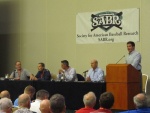SABR 43: Watch/listen to the Statistical Analysis Panel
The SABR 43 Statistical Analysis Panel on Saturday, August 3, 2013, spanned the gamut from the early days of sabermetrics in the 1970s to the “Big Data” approach that many baseball teams are using today. The panel included fantasy baseball expert Steve Mann, sabermetrics pioneer Dick Cramer, Bill Petti of FanGraphs, SABR President Vince Gennaro — and special guest moderator Brian Kenny of MLB Network.
- Video: Watch the SABR 43 Statistical Analysis Panel (YouTube)
- Audio: Listen to the SABR 43 Statistical Analysis Panel (1:37:42; 89.4 MB)
 Here are some highlights:
Here are some highlights:
ON THE USE OF BIG DATA IN BASEBALL
- Gennaro: “I’m finding that some teams have not caught up with the increased power of the data we now have available. So they’re framing their questions in a rather conservative way … when in reality, we can ask much more sophisticated questions than we ever thought we could ask before. … For example, how often does a pitcher throw a changeup? Well, why don’t we look at it in terms of pitch sequencing? So now we can really add some texture to it and understand the answer at a much higher level. … But it’s not easy to gravitate to asking the questions that are big enough to take advantage of the power we have now.”
ON SCOUTING AND STATISTICS
- Petti: “Scouts have always been trying to put some kind of a number on what they see. This player has 70 power versus this player has 40 power. Well, now we can go even deeper and dig into the numbers. So when we say this player has 70 power, how do we know he actually has 70 power? Now we can look at it. How long does the ball actually travel off the bat? What is the launch angle? What is the launch velocity? You can dig in at a much more granular level than we’ve ever been able to do before. You can make better decisions, and better evaluate players, when you have that level of detail.”
ON THE STATE OF SABERMETRIC ANALYSIS IN THE 1970S
- Mann: “First of all, there were no really useful statistics that had been hammered out yet (in the 1970s.) The problem is, you’ve got so many elements to deal with … how can you pull that apart and figure out where runs came from? Runs determine wins. But the question is, where do runs come from? … I was not really a math guy, per se, but I played APBA … so in preparing for a draft, I asked myself a question: ‘Would I rather draft Pete Rose or Mike Schmidt?’ This was in the mid-1970s. But I didn’t know which of them would give me more runs. So I went back to the play-by-play data for one full season, and I figured out what all these events were worth: a single, a double, a triple, a home run, etc. So I ended up with a simple approach, but it turned out to be pretty good. And one thing led to another and it created a career for me.”
- Cramer: “It was really just curiosity. I lived in Boston at the time, and Ted Williams was either really popular or not popular depending on which columnist you were reading. It seemed to me the notion that Ted Williams wasn’t a clutch hitter didn’t make a lot of sense to me. So I wanted to see whether if you moved Ted Williams to any team, would he contribute the same number of runs? It was simple curiosity. … The practical applications only came about later, and that’s another story.”
For more coverage of SABR 43, visit SABR.org/convention.
Originally published: August 13, 2013. Last Updated: July 27, 2020.


